BCO5501 - Business Process Engineering: Intelligent BPM & Big Data
VerifiedAdded on 2023/06/03
|9
|2391
|332
Essay
AI Summary
This essay provides a comprehensive review of Business Process Engineering (BPM), focusing on the transition from traditional BPM to Intelligent Business Process Management (iBPM) in the era of Big Data. It analyzes the fundamentals of BPM, its utility in organizational operations, and the role of automation and intelligent systems in modern enterprise architecture. The essay discusses the limitations of traditional BPM, the advantages of iBPM, and the impact of Big Data on data processing, storage, and analysis. It also highlights the importance of adaptability, analytical quality, and data governance in iBPM systems, concluding that iBPM offers significant improvements in execution, monitoring, and controlling operations compared to traditional BPM, though the reviewed article lacks real-time data presentation and empirical validation. Desklib offers a wide range of solved assignments and study resources for students.

Running head: BUSINESS PROCESS ENGINEERING
Business Process Engineering
Name of the Student
Name of the University
Author note
Business Process Engineering
Name of the Student
Name of the University
Author note
Paraphrase This Document
Need a fresh take? Get an instant paraphrase of this document with our AI Paraphraser
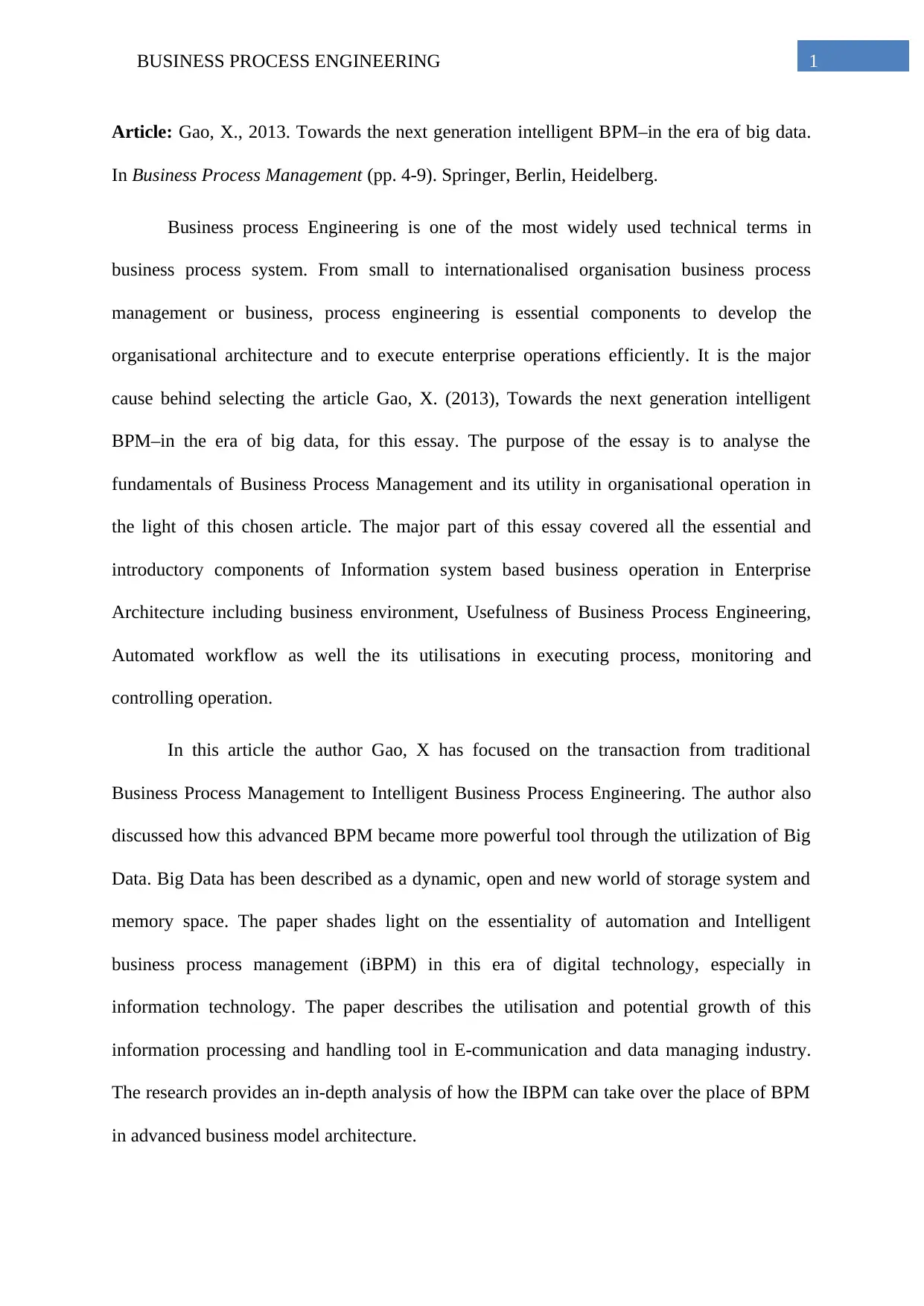
1BUSINESS PROCESS ENGINEERING
Article: Gao, X., 2013. Towards the next generation intelligent BPM–in the era of big data.
In Business Process Management (pp. 4-9). Springer, Berlin, Heidelberg.
Business process Engineering is one of the most widely used technical terms in
business process system. From small to internationalised organisation business process
management or business, process engineering is essential components to develop the
organisational architecture and to execute enterprise operations efficiently. It is the major
cause behind selecting the article Gao, X. (2013), Towards the next generation intelligent
BPM–in the era of big data, for this essay. The purpose of the essay is to analyse the
fundamentals of Business Process Management and its utility in organisational operation in
the light of this chosen article. The major part of this essay covered all the essential and
introductory components of Information system based business operation in Enterprise
Architecture including business environment, Usefulness of Business Process Engineering,
Automated workflow as well the its utilisations in executing process, monitoring and
controlling operation.
In this article the author Gao, X has focused on the transaction from traditional
Business Process Management to Intelligent Business Process Engineering. The author also
discussed how this advanced BPM became more powerful tool through the utilization of Big
Data. Big Data has been described as a dynamic, open and new world of storage system and
memory space. The paper shades light on the essentiality of automation and Intelligent
business process management (iBPM) in this era of digital technology, especially in
information technology. The paper describes the utilisation and potential growth of this
information processing and handling tool in E-communication and data managing industry.
The research provides an in-depth analysis of how the IBPM can take over the place of BPM
in advanced business model architecture.
Article: Gao, X., 2013. Towards the next generation intelligent BPM–in the era of big data.
In Business Process Management (pp. 4-9). Springer, Berlin, Heidelberg.
Business process Engineering is one of the most widely used technical terms in
business process system. From small to internationalised organisation business process
management or business, process engineering is essential components to develop the
organisational architecture and to execute enterprise operations efficiently. It is the major
cause behind selecting the article Gao, X. (2013), Towards the next generation intelligent
BPM–in the era of big data, for this essay. The purpose of the essay is to analyse the
fundamentals of Business Process Management and its utility in organisational operation in
the light of this chosen article. The major part of this essay covered all the essential and
introductory components of Information system based business operation in Enterprise
Architecture including business environment, Usefulness of Business Process Engineering,
Automated workflow as well the its utilisations in executing process, monitoring and
controlling operation.
In this article the author Gao, X has focused on the transaction from traditional
Business Process Management to Intelligent Business Process Engineering. The author also
discussed how this advanced BPM became more powerful tool through the utilization of Big
Data. Big Data has been described as a dynamic, open and new world of storage system and
memory space. The paper shades light on the essentiality of automation and Intelligent
business process management (iBPM) in this era of digital technology, especially in
information technology. The paper describes the utilisation and potential growth of this
information processing and handling tool in E-communication and data managing industry.
The research provides an in-depth analysis of how the IBPM can take over the place of BPM
in advanced business model architecture.
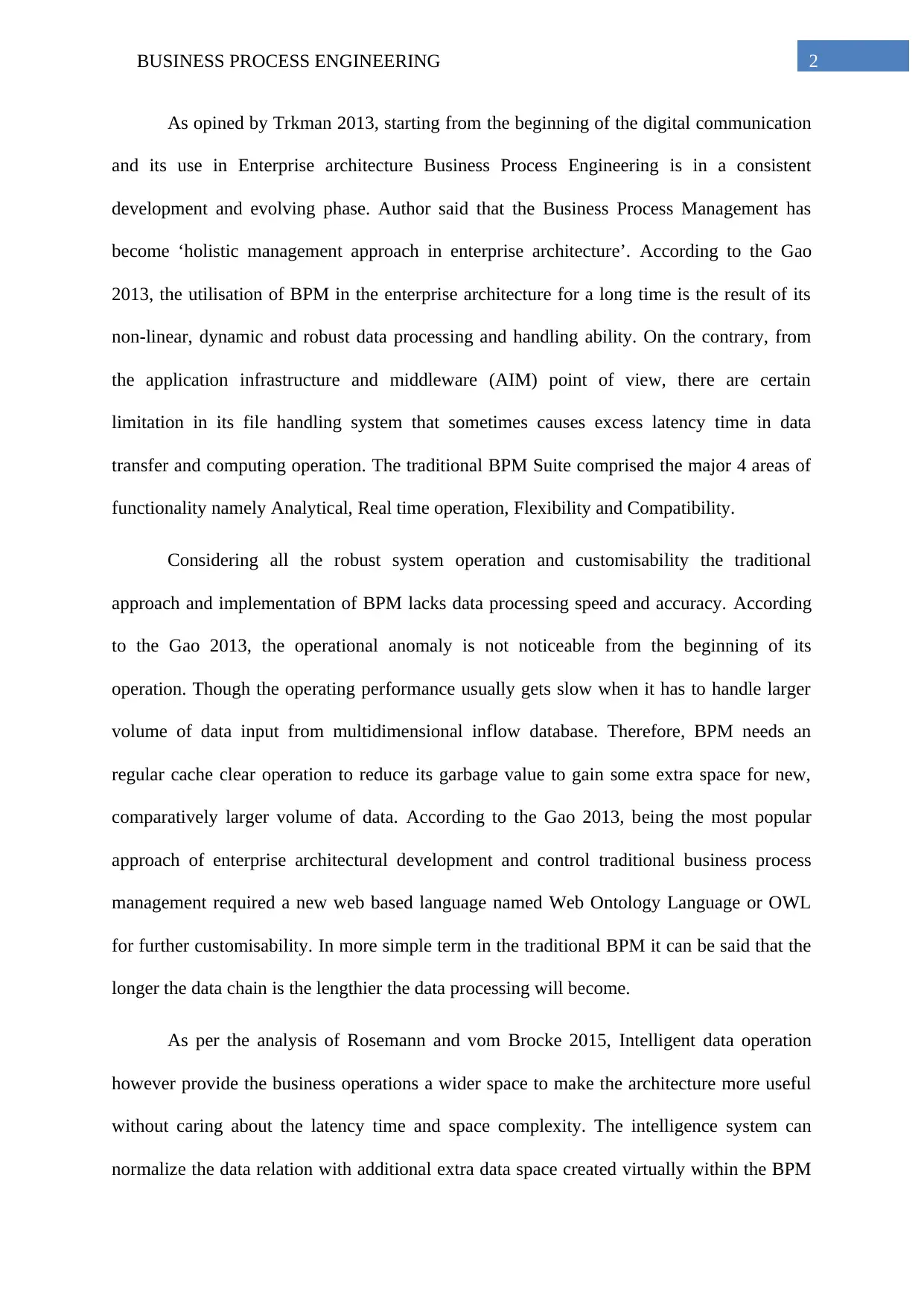
2BUSINESS PROCESS ENGINEERING
As opined by Trkman 2013, starting from the beginning of the digital communication
and its use in Enterprise architecture Business Process Engineering is in a consistent
development and evolving phase. Author said that the Business Process Management has
become ‘holistic management approach in enterprise architecture’. According to the Gao
2013, the utilisation of BPM in the enterprise architecture for a long time is the result of its
non-linear, dynamic and robust data processing and handling ability. On the contrary, from
the application infrastructure and middleware (AIM) point of view, there are certain
limitation in its file handling system that sometimes causes excess latency time in data
transfer and computing operation. The traditional BPM Suite comprised the major 4 areas of
functionality namely Analytical, Real time operation, Flexibility and Compatibility.
Considering all the robust system operation and customisability the traditional
approach and implementation of BPM lacks data processing speed and accuracy. According
to the Gao 2013, the operational anomaly is not noticeable from the beginning of its
operation. Though the operating performance usually gets slow when it has to handle larger
volume of data input from multidimensional inflow database. Therefore, BPM needs an
regular cache clear operation to reduce its garbage value to gain some extra space for new,
comparatively larger volume of data. According to the Gao 2013, being the most popular
approach of enterprise architectural development and control traditional business process
management required a new web based language named Web Ontology Language or OWL
for further customisability. In more simple term in the traditional BPM it can be said that the
longer the data chain is the lengthier the data processing will become.
As per the analysis of Rosemann and vom Brocke 2015, Intelligent data operation
however provide the business operations a wider space to make the architecture more useful
without caring about the latency time and space complexity. The intelligence system can
normalize the data relation with additional extra data space created virtually within the BPM
As opined by Trkman 2013, starting from the beginning of the digital communication
and its use in Enterprise architecture Business Process Engineering is in a consistent
development and evolving phase. Author said that the Business Process Management has
become ‘holistic management approach in enterprise architecture’. According to the Gao
2013, the utilisation of BPM in the enterprise architecture for a long time is the result of its
non-linear, dynamic and robust data processing and handling ability. On the contrary, from
the application infrastructure and middleware (AIM) point of view, there are certain
limitation in its file handling system that sometimes causes excess latency time in data
transfer and computing operation. The traditional BPM Suite comprised the major 4 areas of
functionality namely Analytical, Real time operation, Flexibility and Compatibility.
Considering all the robust system operation and customisability the traditional
approach and implementation of BPM lacks data processing speed and accuracy. According
to the Gao 2013, the operational anomaly is not noticeable from the beginning of its
operation. Though the operating performance usually gets slow when it has to handle larger
volume of data input from multidimensional inflow database. Therefore, BPM needs an
regular cache clear operation to reduce its garbage value to gain some extra space for new,
comparatively larger volume of data. According to the Gao 2013, being the most popular
approach of enterprise architectural development and control traditional business process
management required a new web based language named Web Ontology Language or OWL
for further customisability. In more simple term in the traditional BPM it can be said that the
longer the data chain is the lengthier the data processing will become.
As per the analysis of Rosemann and vom Brocke 2015, Intelligent data operation
however provide the business operations a wider space to make the architecture more useful
without caring about the latency time and space complexity. The intelligence system can
normalize the data relation with additional extra data space created virtually within the BPM
⊘ This is a preview!⊘
Do you want full access?
Subscribe today to unlock all pages.

Trusted by 1+ million students worldwide
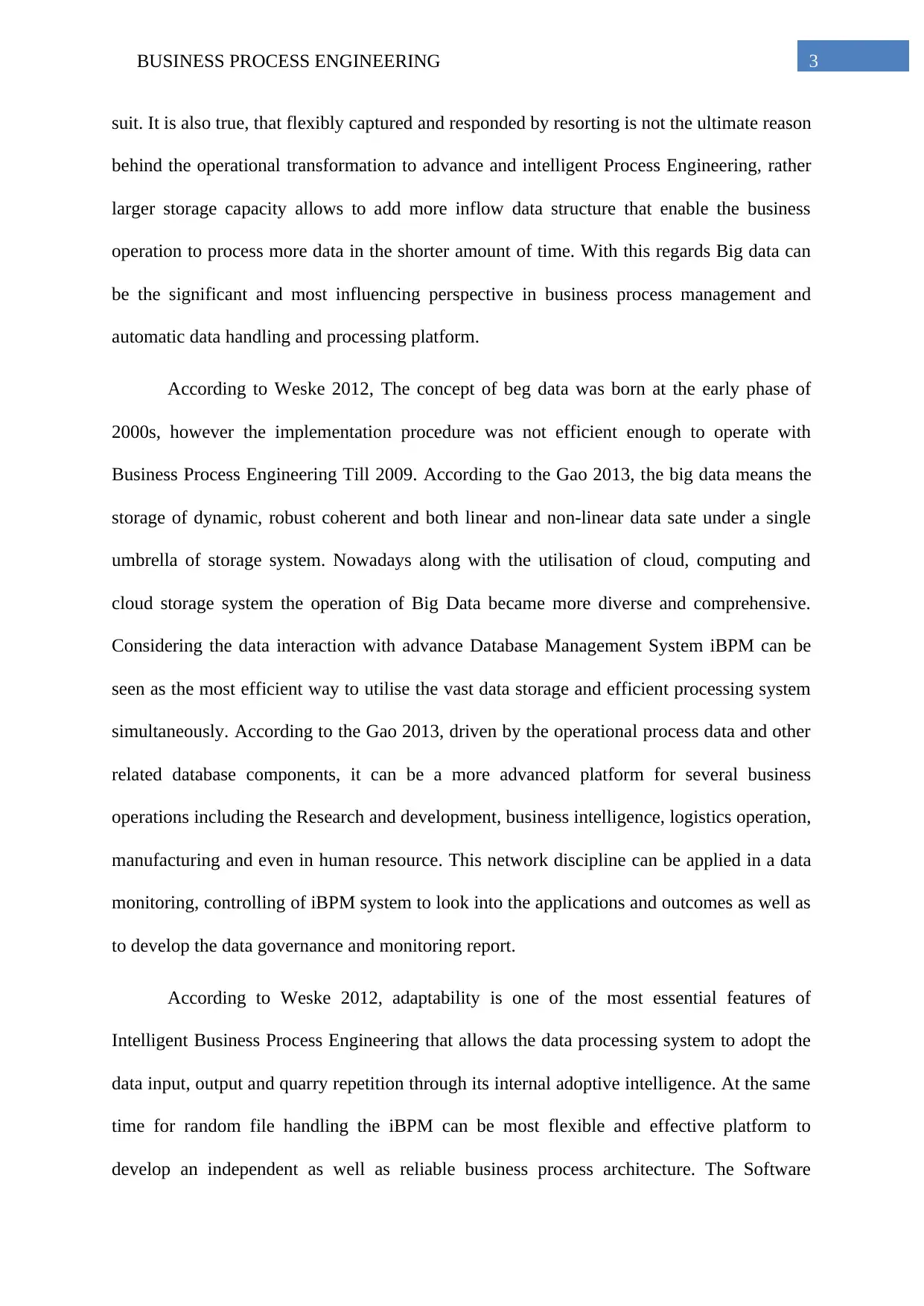
3BUSINESS PROCESS ENGINEERING
suit. It is also true, that flexibly captured and responded by resorting is not the ultimate reason
behind the operational transformation to advance and intelligent Process Engineering, rather
larger storage capacity allows to add more inflow data structure that enable the business
operation to process more data in the shorter amount of time. With this regards Big data can
be the significant and most influencing perspective in business process management and
automatic data handling and processing platform.
According to Weske 2012, The concept of beg data was born at the early phase of
2000s, however the implementation procedure was not efficient enough to operate with
Business Process Engineering Till 2009. According to the Gao 2013, the big data means the
storage of dynamic, robust coherent and both linear and non-linear data sate under a single
umbrella of storage system. Nowadays along with the utilisation of cloud, computing and
cloud storage system the operation of Big Data became more diverse and comprehensive.
Considering the data interaction with advance Database Management System iBPM can be
seen as the most efficient way to utilise the vast data storage and efficient processing system
simultaneously. According to the Gao 2013, driven by the operational process data and other
related database components, it can be a more advanced platform for several business
operations including the Research and development, business intelligence, logistics operation,
manufacturing and even in human resource. This network discipline can be applied in a data
monitoring, controlling of iBPM system to look into the applications and outcomes as well as
to develop the data governance and monitoring report.
According to Weske 2012, adaptability is one of the most essential features of
Intelligent Business Process Engineering that allows the data processing system to adopt the
data input, output and quarry repetition through its internal adoptive intelligence. At the same
time for random file handling the iBPM can be most flexible and effective platform to
develop an independent as well as reliable business process architecture. The Software
suit. It is also true, that flexibly captured and responded by resorting is not the ultimate reason
behind the operational transformation to advance and intelligent Process Engineering, rather
larger storage capacity allows to add more inflow data structure that enable the business
operation to process more data in the shorter amount of time. With this regards Big data can
be the significant and most influencing perspective in business process management and
automatic data handling and processing platform.
According to Weske 2012, The concept of beg data was born at the early phase of
2000s, however the implementation procedure was not efficient enough to operate with
Business Process Engineering Till 2009. According to the Gao 2013, the big data means the
storage of dynamic, robust coherent and both linear and non-linear data sate under a single
umbrella of storage system. Nowadays along with the utilisation of cloud, computing and
cloud storage system the operation of Big Data became more diverse and comprehensive.
Considering the data interaction with advance Database Management System iBPM can be
seen as the most efficient way to utilise the vast data storage and efficient processing system
simultaneously. According to the Gao 2013, driven by the operational process data and other
related database components, it can be a more advanced platform for several business
operations including the Research and development, business intelligence, logistics operation,
manufacturing and even in human resource. This network discipline can be applied in a data
monitoring, controlling of iBPM system to look into the applications and outcomes as well as
to develop the data governance and monitoring report.
According to Weske 2012, adaptability is one of the most essential features of
Intelligent Business Process Engineering that allows the data processing system to adopt the
data input, output and quarry repetition through its internal adoptive intelligence. At the same
time for random file handling the iBPM can be most flexible and effective platform to
develop an independent as well as reliable business process architecture. The Software
Paraphrase This Document
Need a fresh take? Get an instant paraphrase of this document with our AI Paraphraser
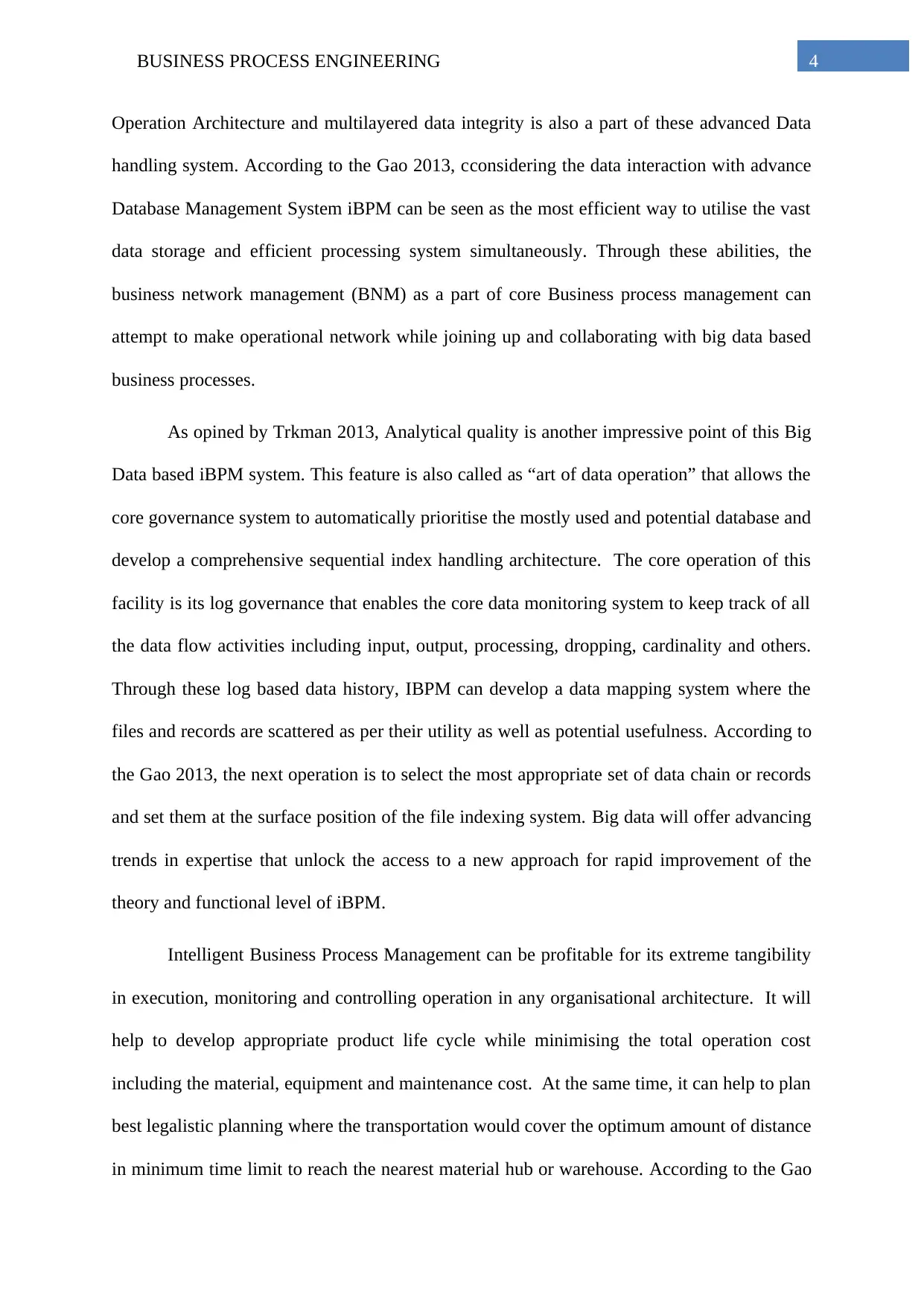
4BUSINESS PROCESS ENGINEERING
Operation Architecture and multilayered data integrity is also a part of these advanced Data
handling system. According to the Gao 2013, cconsidering the data interaction with advance
Database Management System iBPM can be seen as the most efficient way to utilise the vast
data storage and efficient processing system simultaneously. Through these abilities, the
business network management (BNM) as a part of core Business process management can
attempt to make operational network while joining up and collaborating with big data based
business processes.
As opined by Trkman 2013, Analytical quality is another impressive point of this Big
Data based iBPM system. This feature is also called as “art of data operation” that allows the
core governance system to automatically prioritise the mostly used and potential database and
develop a comprehensive sequential index handling architecture. The core operation of this
facility is its log governance that enables the core data monitoring system to keep track of all
the data flow activities including input, output, processing, dropping, cardinality and others.
Through these log based data history, IBPM can develop a data mapping system where the
files and records are scattered as per their utility as well as potential usefulness. According to
the Gao 2013, the next operation is to select the most appropriate set of data chain or records
and set them at the surface position of the file indexing system. Big data will offer advancing
trends in expertise that unlock the access to a new approach for rapid improvement of the
theory and functional level of iBPM.
Intelligent Business Process Management can be profitable for its extreme tangibility
in execution, monitoring and controlling operation in any organisational architecture. It will
help to develop appropriate product life cycle while minimising the total operation cost
including the material, equipment and maintenance cost. At the same time, it can help to plan
best legalistic planning where the transportation would cover the optimum amount of distance
in minimum time limit to reach the nearest material hub or warehouse. According to the Gao
Operation Architecture and multilayered data integrity is also a part of these advanced Data
handling system. According to the Gao 2013, cconsidering the data interaction with advance
Database Management System iBPM can be seen as the most efficient way to utilise the vast
data storage and efficient processing system simultaneously. Through these abilities, the
business network management (BNM) as a part of core Business process management can
attempt to make operational network while joining up and collaborating with big data based
business processes.
As opined by Trkman 2013, Analytical quality is another impressive point of this Big
Data based iBPM system. This feature is also called as “art of data operation” that allows the
core governance system to automatically prioritise the mostly used and potential database and
develop a comprehensive sequential index handling architecture. The core operation of this
facility is its log governance that enables the core data monitoring system to keep track of all
the data flow activities including input, output, processing, dropping, cardinality and others.
Through these log based data history, IBPM can develop a data mapping system where the
files and records are scattered as per their utility as well as potential usefulness. According to
the Gao 2013, the next operation is to select the most appropriate set of data chain or records
and set them at the surface position of the file indexing system. Big data will offer advancing
trends in expertise that unlock the access to a new approach for rapid improvement of the
theory and functional level of iBPM.
Intelligent Business Process Management can be profitable for its extreme tangibility
in execution, monitoring and controlling operation in any organisational architecture. It will
help to develop appropriate product life cycle while minimising the total operation cost
including the material, equipment and maintenance cost. At the same time, it can help to plan
best legalistic planning where the transportation would cover the optimum amount of distance
in minimum time limit to reach the nearest material hub or warehouse. According to the Gao
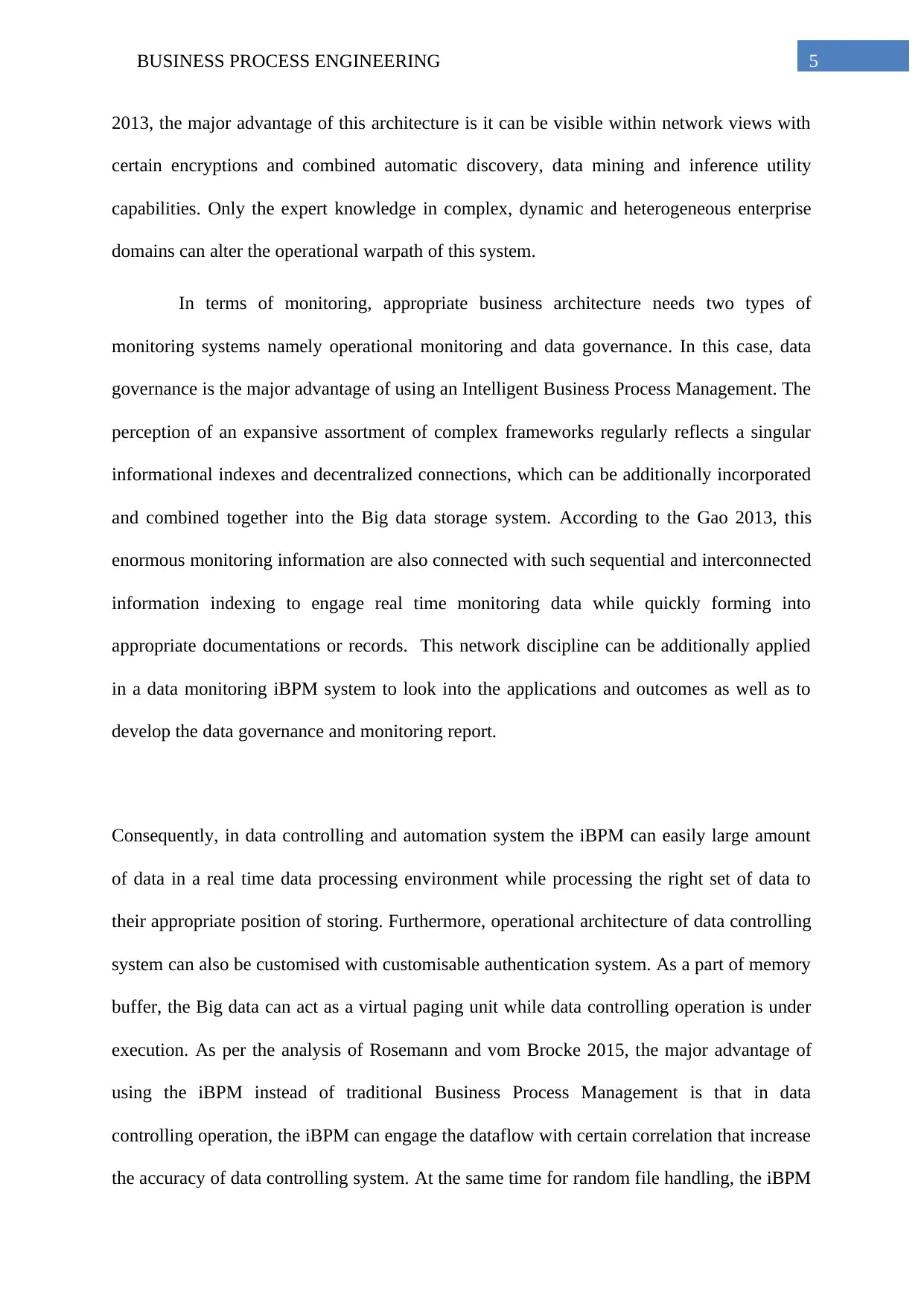
5BUSINESS PROCESS ENGINEERING
2013, the major advantage of this architecture is it can be visible within network views with
certain encryptions and combined automatic discovery, data mining and inference utility
capabilities. Only the expert knowledge in complex, dynamic and heterogeneous enterprise
domains can alter the operational warpath of this system.
In terms of monitoring, appropriate business architecture needs two types of
monitoring systems namely operational monitoring and data governance. In this case, data
governance is the major advantage of using an Intelligent Business Process Management. The
perception of an expansive assortment of complex frameworks regularly reflects a singular
informational indexes and decentralized connections, which can be additionally incorporated
and combined together into the Big data storage system. According to the Gao 2013, this
enormous monitoring information are also connected with such sequential and interconnected
information indexing to engage real time monitoring data while quickly forming into
appropriate documentations or records. This network discipline can be additionally applied
in a data monitoring iBPM system to look into the applications and outcomes as well as to
develop the data governance and monitoring report.
Consequently, in data controlling and automation system the iBPM can easily large amount
of data in a real time data processing environment while processing the right set of data to
their appropriate position of storing. Furthermore, operational architecture of data controlling
system can also be customised with customisable authentication system. As a part of memory
buffer, the Big data can act as a virtual paging unit while data controlling operation is under
execution. As per the analysis of Rosemann and vom Brocke 2015, the major advantage of
using the iBPM instead of traditional Business Process Management is that in data
controlling operation, the iBPM can engage the dataflow with certain correlation that increase
the accuracy of data controlling system. At the same time for random file handling, the iBPM
2013, the major advantage of this architecture is it can be visible within network views with
certain encryptions and combined automatic discovery, data mining and inference utility
capabilities. Only the expert knowledge in complex, dynamic and heterogeneous enterprise
domains can alter the operational warpath of this system.
In terms of monitoring, appropriate business architecture needs two types of
monitoring systems namely operational monitoring and data governance. In this case, data
governance is the major advantage of using an Intelligent Business Process Management. The
perception of an expansive assortment of complex frameworks regularly reflects a singular
informational indexes and decentralized connections, which can be additionally incorporated
and combined together into the Big data storage system. According to the Gao 2013, this
enormous monitoring information are also connected with such sequential and interconnected
information indexing to engage real time monitoring data while quickly forming into
appropriate documentations or records. This network discipline can be additionally applied
in a data monitoring iBPM system to look into the applications and outcomes as well as to
develop the data governance and monitoring report.
Consequently, in data controlling and automation system the iBPM can easily large amount
of data in a real time data processing environment while processing the right set of data to
their appropriate position of storing. Furthermore, operational architecture of data controlling
system can also be customised with customisable authentication system. As a part of memory
buffer, the Big data can act as a virtual paging unit while data controlling operation is under
execution. As per the analysis of Rosemann and vom Brocke 2015, the major advantage of
using the iBPM instead of traditional Business Process Management is that in data
controlling operation, the iBPM can engage the dataflow with certain correlation that increase
the accuracy of data controlling system. At the same time for random file handling, the iBPM
⊘ This is a preview!⊘
Do you want full access?
Subscribe today to unlock all pages.

Trusted by 1+ million students worldwide
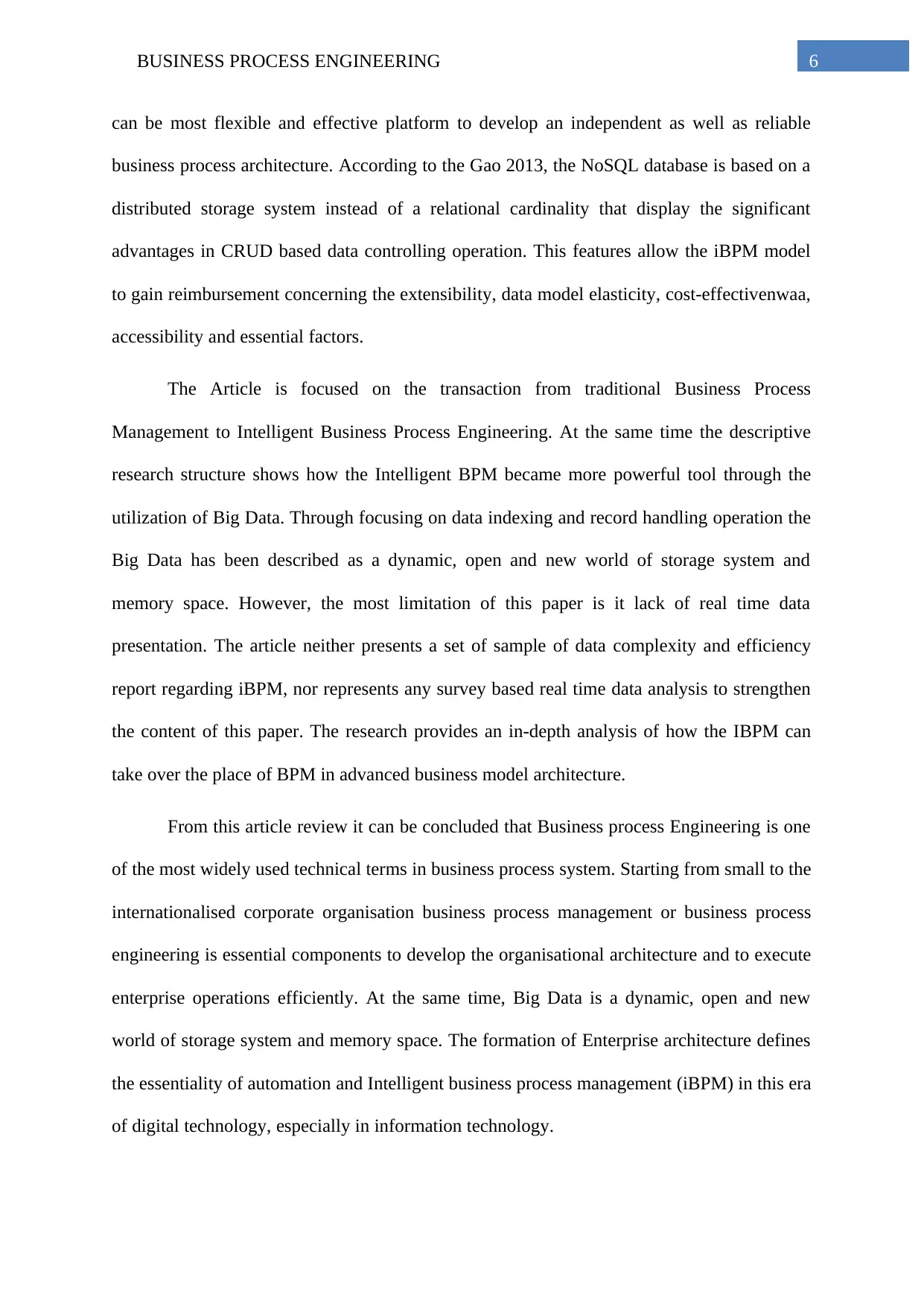
6BUSINESS PROCESS ENGINEERING
can be most flexible and effective platform to develop an independent as well as reliable
business process architecture. According to the Gao 2013, the NoSQL database is based on a
distributed storage system instead of a relational cardinality that display the significant
advantages in CRUD based data controlling operation. This features allow the iBPM model
to gain reimbursement concerning the extensibility, data model elasticity, cost-effectivenwaa,
accessibility and essential factors.
The Article is focused on the transaction from traditional Business Process
Management to Intelligent Business Process Engineering. At the same time the descriptive
research structure shows how the Intelligent BPM became more powerful tool through the
utilization of Big Data. Through focusing on data indexing and record handling operation the
Big Data has been described as a dynamic, open and new world of storage system and
memory space. However, the most limitation of this paper is it lack of real time data
presentation. The article neither presents a set of sample of data complexity and efficiency
report regarding iBPM, nor represents any survey based real time data analysis to strengthen
the content of this paper. The research provides an in-depth analysis of how the IBPM can
take over the place of BPM in advanced business model architecture.
From this article review it can be concluded that Business process Engineering is one
of the most widely used technical terms in business process system. Starting from small to the
internationalised corporate organisation business process management or business process
engineering is essential components to develop the organisational architecture and to execute
enterprise operations efficiently. At the same time, Big Data is a dynamic, open and new
world of storage system and memory space. The formation of Enterprise architecture defines
the essentiality of automation and Intelligent business process management (iBPM) in this era
of digital technology, especially in information technology.
can be most flexible and effective platform to develop an independent as well as reliable
business process architecture. According to the Gao 2013, the NoSQL database is based on a
distributed storage system instead of a relational cardinality that display the significant
advantages in CRUD based data controlling operation. This features allow the iBPM model
to gain reimbursement concerning the extensibility, data model elasticity, cost-effectivenwaa,
accessibility and essential factors.
The Article is focused on the transaction from traditional Business Process
Management to Intelligent Business Process Engineering. At the same time the descriptive
research structure shows how the Intelligent BPM became more powerful tool through the
utilization of Big Data. Through focusing on data indexing and record handling operation the
Big Data has been described as a dynamic, open and new world of storage system and
memory space. However, the most limitation of this paper is it lack of real time data
presentation. The article neither presents a set of sample of data complexity and efficiency
report regarding iBPM, nor represents any survey based real time data analysis to strengthen
the content of this paper. The research provides an in-depth analysis of how the IBPM can
take over the place of BPM in advanced business model architecture.
From this article review it can be concluded that Business process Engineering is one
of the most widely used technical terms in business process system. Starting from small to the
internationalised corporate organisation business process management or business process
engineering is essential components to develop the organisational architecture and to execute
enterprise operations efficiently. At the same time, Big Data is a dynamic, open and new
world of storage system and memory space. The formation of Enterprise architecture defines
the essentiality of automation and Intelligent business process management (iBPM) in this era
of digital technology, especially in information technology.
Paraphrase This Document
Need a fresh take? Get an instant paraphrase of this document with our AI Paraphraser

7BUSINESS PROCESS ENGINEERING
As per the paper, according to the application infrastructure and middleware (AIM)
point of view, there are certain limitation in its file handling system that sometimes causes
excess latency time in data transfer and computing operation. Along with that through log
based data records and history management, IBPM can develop a data mapping system where
the files and records are scattered as per their utility as well as potential usefulness. In can be
concluded that Big data will offer advancing trends in expertise that unlock the access to a
new approach for rapid improvement of the theory and functional level of iBPM. At the same
time, the NoSQL database can provide a distributed storage system instead of a relational
cardinality, which also shows the significant advantages in CRUD based data management.
As per the paper, according to the application infrastructure and middleware (AIM)
point of view, there are certain limitation in its file handling system that sometimes causes
excess latency time in data transfer and computing operation. Along with that through log
based data records and history management, IBPM can develop a data mapping system where
the files and records are scattered as per their utility as well as potential usefulness. In can be
concluded that Big data will offer advancing trends in expertise that unlock the access to a
new approach for rapid improvement of the theory and functional level of iBPM. At the same
time, the NoSQL database can provide a distributed storage system instead of a relational
cardinality, which also shows the significant advantages in CRUD based data management.
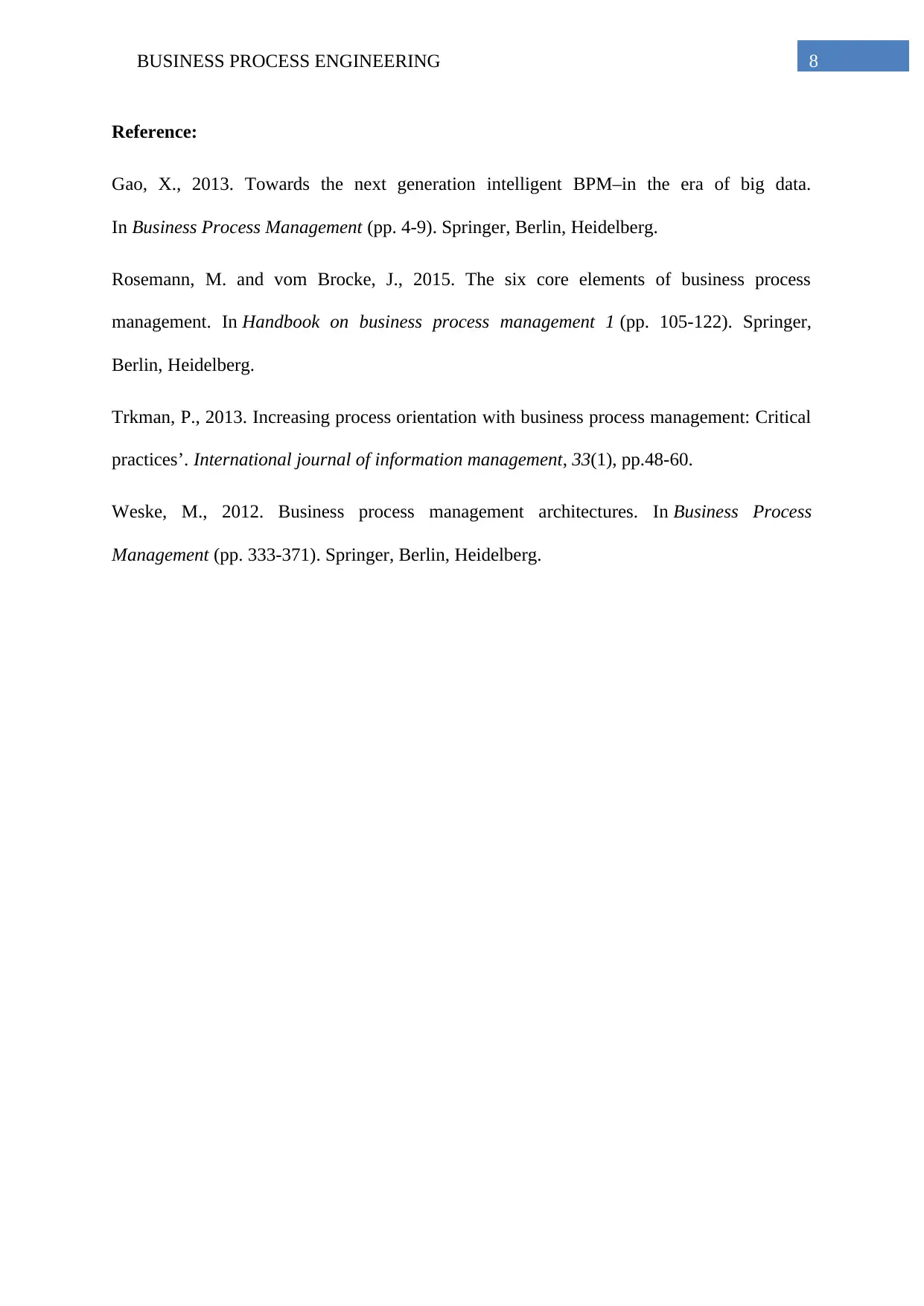
8BUSINESS PROCESS ENGINEERING
Reference:
Gao, X., 2013. Towards the next generation intelligent BPM–in the era of big data.
In Business Process Management (pp. 4-9). Springer, Berlin, Heidelberg.
Rosemann, M. and vom Brocke, J., 2015. The six core elements of business process
management. In Handbook on business process management 1 (pp. 105-122). Springer,
Berlin, Heidelberg.
Trkman, P., 2013. Increasing process orientation with business process management: Critical
practices’. International journal of information management, 33(1), pp.48-60.
Weske, M., 2012. Business process management architectures. In Business Process
Management (pp. 333-371). Springer, Berlin, Heidelberg.
Reference:
Gao, X., 2013. Towards the next generation intelligent BPM–in the era of big data.
In Business Process Management (pp. 4-9). Springer, Berlin, Heidelberg.
Rosemann, M. and vom Brocke, J., 2015. The six core elements of business process
management. In Handbook on business process management 1 (pp. 105-122). Springer,
Berlin, Heidelberg.
Trkman, P., 2013. Increasing process orientation with business process management: Critical
practices’. International journal of information management, 33(1), pp.48-60.
Weske, M., 2012. Business process management architectures. In Business Process
Management (pp. 333-371). Springer, Berlin, Heidelberg.
⊘ This is a preview!⊘
Do you want full access?
Subscribe today to unlock all pages.

Trusted by 1+ million students worldwide
1 out of 9
Related Documents
Your All-in-One AI-Powered Toolkit for Academic Success.
+13062052269
info@desklib.com
Available 24*7 on WhatsApp / Email
![[object Object]](/_next/static/media/star-bottom.7253800d.svg)
Unlock your academic potential
Copyright © 2020–2025 A2Z Services. All Rights Reserved. Developed and managed by ZUCOL.




